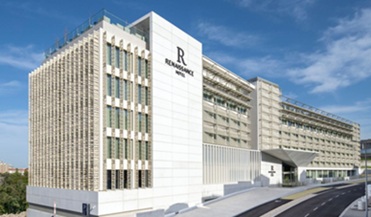Name: Danielle Khoo
Title: Director of Sustainability | Global Design Strategies
Company: Marriott International, Inc.
Years in Current Position: Two years and three months.
Primary Responsibilities: “Lead the sustainability strategy within the design and development processes with a focus on the built environment.”
Company’s most significant accomplishment in design sustainability: “We released updates to new-build standards. It was quite the undertaking to update the standards.”
Company’s most significant challenge moving forward in sustainability: “Minimizing our environmental impact while continuing to grow. Hotel companies are measured by growth. Getting over that hurdle.”

SEATTLE—As Director of Sustainability | Global Design Strategies for Marriott International, Danielle Khoo ensures that new Marriotts coming on board have the smoothest path to smart design and environmental efficiency. Developers, architects and others have access to not only Khoo and her team’s expertise but also Sustainable Building Design Resources such as: Building Envelope Design Guide, Solar Readiness Design Guide, Building Sustainability Certification Toolkit, and Emodeler On-Demand Energy Modeling Tool.
With Marriott since 2018, Khoo previously served as Senior Manager of Engineering | Global Design Strategies for the company for almost five years. In that role she provided quality control of Mechanical, Electrical and Plumbing designs for all 30 hotel brands including new build, adaptive reuse, and conversion projects. She also helped develop a carbon reduction strategy to reduce carbon emissions at the portfolio level in line with the Science Based Targets Initiative.
As a company, Marriott has committed to reach net-zero greenhouse gas emissions across its value chain by 2050.
The current Serve360 report highlighting Marriott’s sustainability achievements and goals was published last year (2024) and covers work that was completed in 2023. Similarly, the report that will be published next month will be the 2025 report that covers progress from 2024.
While leading the sustainability strategy within the design and development processes with a focus on the built environment, Khoo says she provides support to Marriott design stakeholders including consultants working on Marriott projects.
Sustainable Building Certification Pursuits

With hundreds of LEED certified hotels in its portfolio, Marriott strongly supports the U.S. Green Building Council’s efforts to elevate sustainability standards.
“We have tried to align design standards to align with LEED points,” Khoo says, adding that Marriott is not at the point of saying that all LEED projects need to be LEED certified. “From a certification perspective, the company recognizes other certifications are more affordable,” she says.
One shining example of green design in Marriott’s portfolio is the Renaissance Porto Lapa Hotel in Portugal. It is a LEED Platinum-certified hotel. Some highlights of this project:
- The hotel achieves a 40 percent energy savings compared to standard buildings, integrating cutting-edge, renewable lighting, and HVAC systems;
- A rooftop photovoltaic array contributes 12 percent of the hotel’s electricity consumption, enhancing overall energy efficiency;
- A natural metallic shading structure at the entrance optimizes interior temperature control, harmonizing with the building’s exceptional thermal performance;
- An impressive 40 percent reduction in potable water usage for sanitary purposes; and
- Innovative rainwater reuse accounts for 55 percent of sanitary flushes, while a 70 percent decrease in water consumption caters to efficient irrigation practices.
Khoo also highlighted the upcoming 2026 Tribute Portfolio Sugar House Hotel (name not finalized) in Burlington, Vermont—a hotel aiming to be net-zero, meaning it was designed to have a net-zero operational carbon footprint and won’t rely on fossil fuels for energy.
Khoo emphasized the importance of good green design thinking early in the design process. One example, she says: “You can’t recycle or compost if you do not have the space to do it.”
Hundreds of Adaptive Use Projects
Reflective of the thinking that the best green hotel is one that is already built, Khoo says Marriott reached its 2025 goal of partnering with owners to develop 250 adaptive reuse projects.
Net zero energy and emissions are hot topics in the industry today, Khoo says. “When talking about net zero, it is important to know what that means,” she says. “There are different definitions of net zero. (See related article.) “Wellness, especially for luxury, has also been top of mind for the industry.”
In Search of Incentives
Last year, Marriott conducted an incentive pilot with IncentiFind, a company that makes it easy to find and capture green building incentive savings. “Because IncentiFind does a scrub for projects, it was amazing to see the available incentives,” Khoo says. “They do the application for the owner.”
A graduate of the University of Maryland with a BS in Mechanical Engineering, Khoo says what she most enjoys about her work is getting to do something she is passionate about.
A “catalyst for better buildings in hospitality” is how she describes herself in her LinkedIn profile.
Glenn Hasek can be reached at greenlodgingnews@gmail.com.





